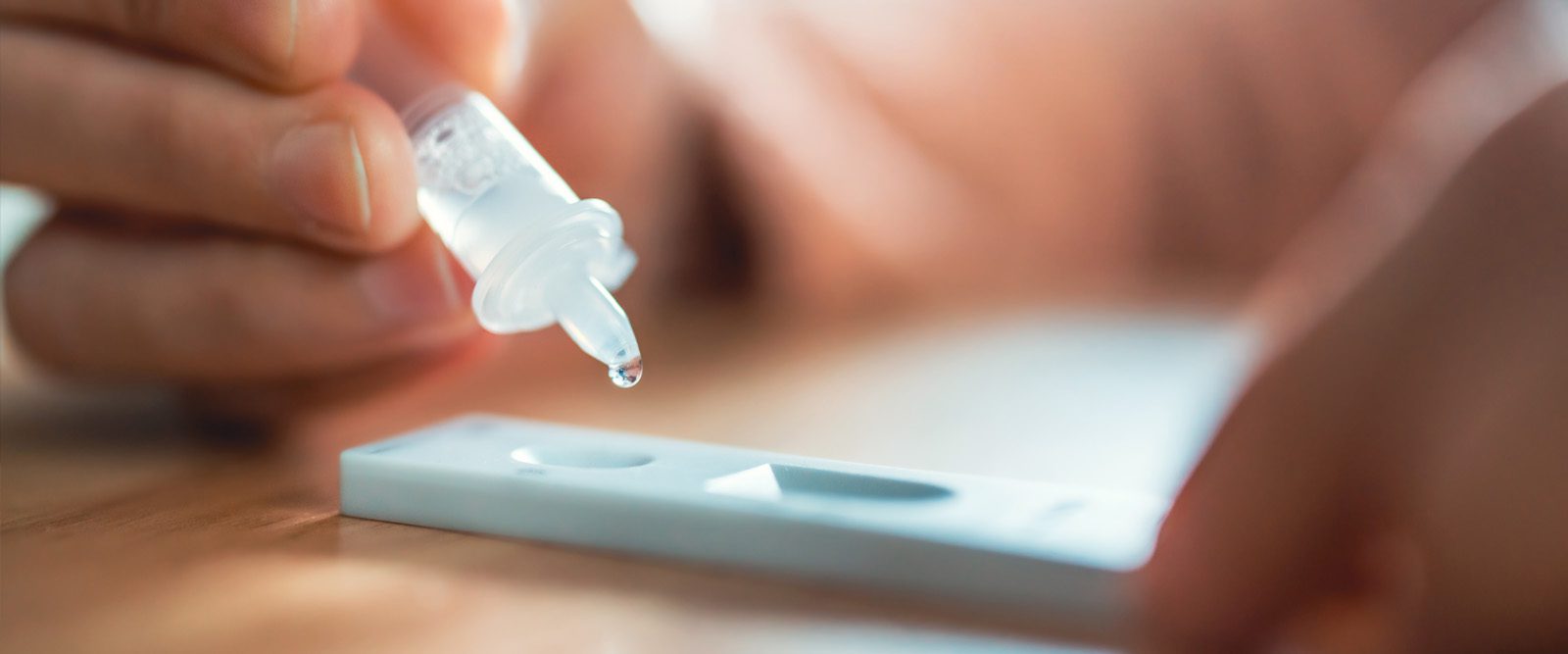What to Know About COVID-19 Tests
An epidemiologist discusses the latest on COVID-19 testing, including if at-home tests can detect the latest variant.

At-home tests, also referred to as rapid tests, remain a helpful tool that can detect active COVID-19 infection. Today, these diagnostic tests can be found online or at local stores and people can purchase them without a prescription.
“Testing allows for prompt initiation of antiviral therapy for people who may benefit from treatment, which reduces the risk of more severe disease, and prevents spreading the virus to others,” says Dr. David Calfee, chief hospital epidemiologist at NewYork-Presbyterian/Weill Cornell Medical Center and a professor of medicine at Weill Cornell Medicine.
Dr. Calfee shared with Health Matters what to know about rapid and molecular tests, when someone should get tested, and what to do if you test positive. He also provided tips on what people can do to protect themselves.

Dr. David Calfee
What is a COVID-19 rapid test?
Rapid tests detect the presence of one or more proteins that are a part of the virus. Results from rapid tests can be available quickly (they require less complex technology) wherever you have taken the test, such as at home, at a doctor’s office or urgent care. They have a faster turnaround than molecular tests, such as polymerase chain reaction (PCR) tests. Rapid tests are a good tool to have on hand, especially if it is difficult to find a PCR test and you develop symptoms.
Can false positive results occur?
False positive results on rapid tests are rare but because these tests have lower sensitivity, a false negative result is possible. This is important to know because a negative rapid test does not necessarily mean you do not have the virus.
When you should take a rapid test:
- If you begin having COVID-19 symptoms like fever, sore throat, runny nose, or loss of taste or smell. For those with symptoms, testing should be done immediately. If a rapid test is used and the initial test is negative, the test should be repeated in two to three days.
- At least five days after you come into close contact with someone with COVID-19. That is because it can take several days after someone is exposed to and infected with the virus to be detectable.
- Before going to a gathering with a group of people, especially those who are at risk of severe disease or may not be up to date on their COVID-19 vaccines.
If you have symptoms of COVID-19 or have reason to suspect you were exposed, such as having close contact with someone who subsequently tested positive for COVID-19, it is also recommended you confirm a negative rapid test result with a PCR test or with another rapid test two days later.
What is a PCR test?
The PCR and nucleic acid amplification tests are molecular tests. Molecular tests detect the genetic material of the virus, known as RNA. In general, these tests are considered to be the gold standard for diagnosis of COVID-19. They have greater sensitivity than rapid tests, meaning they can detect more of the people who have COVID-19 infection. But it typically takes about 24 hours to get PCR test results and can take even longer if labs are backed up.
PCR tests are more sensitive for the detection of SARS-CoV-2 than rapid tests, meaning that a single negative PCR test can usually be interpreted as the absence of COVID-19 disease. PCR tests can be very helpful if you need a more definitive answer quickly, compared to rapid tests where a second test is needed if the first test is negative.
The CDC’s Increasing Community Access to Testing program for COVID-19 provides testing at no cost for uninsured people who are symptomatic or who have been exposed to COVID-19. A list of testing sites can be found on the COVID-19 Testing Locator website.
If people have rapid tests at home that they have had for a while, what should they know about extended expiration dates?
The expiration dates for some rapid tests have been extended, and the tests can continue to be used for a certain period after the expiration date written on the package. According to the Food and Drug Administration (FDA), an extended expiration date means the manufacturer of the test provided data showing that the shelf life is longer than was known when the test was first authorized.
A list of rapid tests and the current expiration date for these tests is available from the FDA, where people can also see if the expiration date for their test has been extended. The list includes information on where to locate the extended expiration date, who can use the test, links to instructions on how to use them, and other details that may help a person decide which test is right for them.
How long should you stay home if you have COVID-19?
The CDC recommends that if a person has any respiratory illness, including COVID-19, and is experiencing symptoms, they should stay home and away from others. They can return to normal activities when, for at least 24 hours, their symptoms have improved, and if a fever was present, it has been gone without the use of a fever-reducing medication.
When resuming with their schedules, the CDC encourages people to take added precautions over the next 5 days, including taking additional steps for cleaner air (opening windows), hygiene (washing hands), masks, physical distancing, and/or testing when around other people indoors.
These additional steps can help people with more severe COVID-19 disease, such as people over 65 and those who have weakened immune systems.
When should a person consider or start treatment for COVID-19?
Treatment is recommended for those with more severe disease and those with mild or moderate disease who are at increased risk of developing severe disease, including older adults and people who have certain medical conditions such as lung disease, heart disease, or a weakened immune system.
Treatment should be started 5-7 days after the onset of symptoms. A few at-home options include Paxlovid or Lagevrio.
What should people know about Paxlovid rebound?
Rebound, which is a term that has been used to describe testing positive again after initially testing negative following COVID-19 infection or developing recurrent symptoms after initial improvement, can occur with or without treatment with Paxlovid, although it appears to be somewhat more frequent following treatment with Paxlovid.
Symptoms are usually less severe with rebound, but anyone experiencing rebound should closely monitor their symptoms and speak to their doctor if they develop more severe symptoms. Isolation recommendations for a rebound are similar to those for the initial COVID-19 infection.
What are some ways people can protect themselves from respiratory virus infections, such as COVID-19?
Getting vaccinated, not only for COVID-19 but also for the flu and respiratory syncytial virus (RSV). The RSV vaccine is new and available this year for certain groups, such as pregnant persons and adults 60 years of age or older, particularly those with medical conditions that put them at an increased risk of developing severe disease due to RSV.
Other protective measures include hand hygiene, avoiding touching your face and eyes prior to performing hand hygiene, avoiding close contact with individuals who have signs or symptoms of respiratory infection, and improving ventilation in indoor settings, such as opening windows or turning on exhaust fans.
Some people may want to consider wearing a mask when in crowded indoor environments where they cannot avoid close contact with others.
David P. Calfee, M.D., M.S., is the chief hospital epidemiologist at NewYork-Presbyterian/Weill Cornell Medical Center and the deputy medical director of infection prevention and control for NewYork-Presbyterian Hospital. He is also a professor of medicine (infectious diseases) and population health sciences at Weill Cornell Medicine. Dr. Calfee is a Fellow of the Infectious Diseases Society of America and the Society for Healthcare Epidemiology of America and is the editor of Infection Control & Hospital Epidemiology. His research interests include antimicrobial-resistant pathogens and the epidemiology and prevention of healthcare-associated infections.

